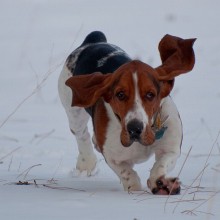Basset Hound
Lifestyle Needs

The origin of the Basset Hound was as a hunting dog whose natural prey is the hare. He likes nothing better than putting his nose to the ground and following a scent. He has a loud, deep bark but is usually friendly nevertheless. He has a short coat which needs weekly grooming. Like all dogs the Basset needs daily exercise. It is best to avoid the extreme type which can cause welfare problems.
Genetic Diversity
(Known as Coefficient of Inbreeding: 'COI'. It should be as low as possible.)
The UK Kennel Club breed average COI is 7.5% - See 'A Beginners Guide to COI'
Gene Pool Size
(Known as Effective Population Size: 'EPS')
74.2
EPS is a measure of how many individuals are contributing genetically to a breed population. It is a measure of the size of the gene pool in a breed. Lower than 100 is considered critical by conservationists and below 50 brings a breed close to extinction. For more information see the Kennel Club article.
Health and Welfare Problems due to Conformation
(Body shape and physical characteristics)
- The Basset is a weighty dog with short legs, and this does impede his movement.
- His skin is rather wrinkled which can lead to infections (skinfold dermatitis)
- His ears are long, often getting in the way when he wants to put nose to ground and follow a scent.
- Due to his chondrodystrophy and disproportionately long back, intervertebral disc disease can be a problem.
- Curved limb bones can occur due to Osteochondroplasia (dwarfism)
- Gastric dilatation volvulus (Bloat) (stomach fills with air and twists) life threatening if not given urgent veterinary treatment
BVA/KC Health Schemes: www.bva.co.uk/chs
- Elbow dysplasia: ideally 0:0
- Eye Scheme: Primary glaucoma / Goniodysgenesis (G) (annual testing)
Identified by the UK Kennel Club as part of their Breed Health and Conservation Plan
Estimated Breeding Values (EBVs) : No EBVs are currently available for this breed
www.thekennelclub.org.uk/about-ebvs
DNA Tests Available
DogWellNet and IPFD Harmonisation of Genetic Testing for Dogs (HGTD)
www.dogwellnet.com/breeds
- Chondrodystrophy (Type 1 IVDD)
- Primary open angle glaucoma (POAG)
- Lafora disease
Availability of a DNA test does not mean that it is always necessary or even desirable for breeders to use this test.
Other Breed-Specific Health Screening Schemes
Basset Hound Health Group Health Certificate
- Patella luxation test
Ask the breeder to show you the certificates for the above tests/screening for both parents. If any of the above tests have not been considered necessary by the breeder (and there may be good reasons), ask her to explain why.
Other Diseases Reported
(For which there are currently no genetic or screening tests for sire or dam)
- Cancer: squamous cell carcinoma; nasal carcinoma; trichoepithelioma; lymphoma
- Intervertebral disc disease (IVDD)
- Eye Disease: Entropion/Ectropion, keratitis, lens luxation, Cherry Eye
- Dermatitis
- Bloat/GDV
- Ear infections
Ask the breeder about the medical history of the parents, grandparents and great grandparents. Consider carefully whether to purchase a puppy if some of these or other diseases are in the family line.
Ask about the breeder’s policy in cases of serious genetic diseases occurring to your puppy in later life. Good breeders will request to be informed of such events in order to improve future breeding decisions.
You are strongly advised to buy from a breeder who uses (or is prepared to use) the AWF Puppy Contract and Puppy Information Pack (PIP): www.puppycontract.org.uk
The breeder should also be familiar with the CFSG/DBRG Code of Practice for Dog Breeding
Or the Kennel Club’s Assured Breeders Scheme Standard and Guidance:
Standard PDF | Guidance PDF